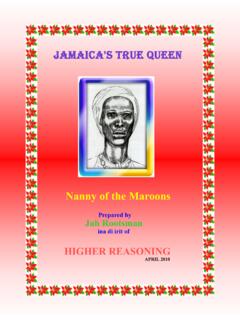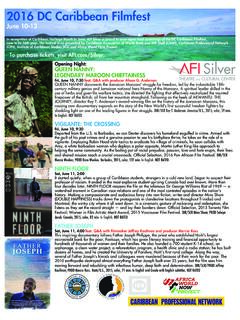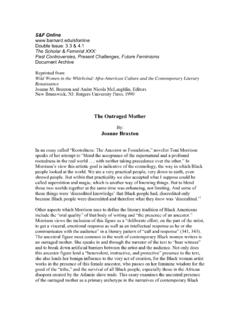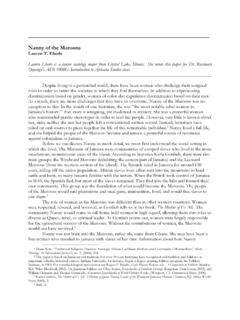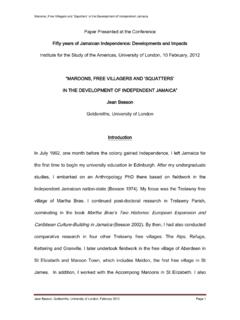Transcription of Kelley - 1 Lindsey Kelley English 598 – Caribbean Texts ...
1 Kelley - 1 Lindsey Kelley English 598 Caribbean Texts & Contexts Dr. Danette DiMarco December 11, 2007 Magic, Myths, and Storytelling in Colonial Caribbean Literature Like the Afro- Caribbean people themselves, traditions and practices were uprooted from lands far away and carried hundreds of miles across deep oceans to a new world where they continued to exist and adapt; Practices rooted in magic, myths, and the oral tradition of storytelling. These stories and practices, like the people who perpetuated them, were displaced, abused, and stripped of their original identity. Traditions provided the Caribbean people with a connection to their homelands and ancestors, and may have provided them with a sense of community and freedom. Contrarily, some traditions and practices were just as controlling as the colonizers and settlers that enslaved them. This paper explores some of the many ways that magic, myths, and the tradition of storytelling persisted in colonial Caribbean , and how they are represented in literature and other media characterizing the region, as well as the roles they played in colonial Afro- Caribbean society, and possible effects they had on the islands enslaved inhabitants.
2 As a result of thousands of Africans being shipped as commodities to the Americas and forced to adapt and meld with their new brethren and surroundings, theological and mythological hybrids began to form in the islands in a process known as syncretism ("Syncretism"). Well known syncretic religions in the Caribbean include Kelley - 2 Rastafarianism (a combination of Old Testament, Caribbean culture, and Marcus Garvey s political movement), as well as Santeria and voodoo (combinations of Western Africa, native Caribbean , and Christian/Catholic beliefs) (Donnell 108) ("Syncretism"). Syncretism takes place when there is an attempt to reconcile disparate or contradictory beliefs often resulting in a combination of those beliefs. As the African slaves were brought to foreign lands, their religious practices were considered to be heathen and were often outlawed by their colonizers. Many were forced to convert to Christianity and to practice a religion and worship a God that was unfamiliar to them.
3 In order to preserve their ways of thinking, many continued to secretly observe their beliefs and adhere to old traditions, which resulted in the hybrid, or syncretized, religions. Practices considered by the colonizers to be heathen included rituals involving sorcery and magic, trance states, possessions, dancing and drumbeating, and sacrifices of the living (often animal, but sometimes human) (Williams vi-xix). Evidence of these non-Christian practices can be found throughout literature and other media representing this region. In Sugar Cane Alley (a film adaptation of Joseph Zobel's novel Black Shack Alley), the slave children are seen fashioning a grass charm for the main character Jos to keep his grandmother from beating him after one of her bowls is accidentally broken. In the Haile Gerima movie Sankofa, the character Mona is magically transported back to reclaim the past (translation of the word sankofa ) as she becomes a plantation slave named Shula. It appears in the film as though she may have been sent to the past by way of incantations and drumming from a mysterious old man known as Sankofa.
4 During her experiences in the past, Shula the slave encounters a clash of religious beliefs where many of the characters secretly hold rituals and initiations (or forms of baptism) into Kelley - 3 the non-Christian faith that they practiced. One of the characters, Shongul, makes use of charms and potions to protect himself and others, while also turning them upon others against their will. At one point, the religiously conflicted Shula is agonizingly forced by the colonizers to renounce her heathen religion and profess loyalty to God and Christianity. Storytelling was another way for slaves to connect with their past and ancestry. The oral tradition of storytelling was often times the only way for imported slaves to pass down historical and embellished accounts of their homeland, as well as time-honored tales and fables. One character that turns up time and time again in Caribbean storytelling is that of Anansi, a West African trickster - part spider, part man (and sometimes one or the other) - whose stories exist for entertainment, as well as to teach lessons.
5 Many stories depict the crafty Anansi using his wits to trick his fellow beings (insects and animals) into forfeiting food or possessions, sometimes getting himself into more trouble than he was prior to his foolery. A parallel can be drawn between the lessons of Anansi and one particular scene in the film Sugar Cane Alley. The slave children, left to their own devices while their parents work in the sugarcane fields, find an egg and decide to cook it. However, without matches, they are unable to light a fire on which to cook the egg. One young girl, seemingly innocent, uses deception and her knowledge of the tab or credit system in place at the plantation store to fool the store clerk into giving her matches and a bottle of rum. Instead of cooking the egg, the children get drunk off of the rum and end up burning down one of the shacks with the matches. Kelley - 4 Not all Anansi stories result in trouble for the spider. Depending upon the lesson of the story, listeners are told to beware of Anansi s folly, or sometimes to follow his example (Auld).
6 In the quote below from Martha Warren Beckwith, there is a description of an Anansi character that represents more than the trickster of folklore. Beckwith suggests that Anansi took on the role of a hero and exemplified revolution; perhaps even encouraging decolonization: Anansi is the spirit of rebellion; he is able to overturn the social order; he can marry the Kings' daughter, create wealth out of thin air; baffle the Devil and cheat For an oppressed people Anansi conveyed a simple message from one generation to the next:--that freedom and dignity are worth fighting for, at any odds (Beckwith). The folklore of Anansi survived the journey on slave ships, but his stories are seldom heard in modern times. Mary Adella Wolcott expresses this sentiment in her poem Nana from 1904: The strange Anancy stories, / And legends weird and old / Which after patient coaxing / Were in the twilight told / To breathless, wide-eyed children - / We hardly hear to-day; / A few faint echoes linger - / The rest have passed away, (Donnell 42-3).
7 In the December 2007 issue of Caribbean Beat magazine, Emily Zobel Marshall provides written accounts of her doctoral research in an article titled Tracking Anansi, in which she travels to the isolated Jamaican Maroon country to see whether Anansi still maintained cultural influence in Jamaica today. The Maroon people of Jamaica are descendents of slaves who escaped captivity and fled to the hills of the island where they live today. While many people that Marshall encountered along her journey echoed the Kelley - 5 same sentiment as Walcott s poem Nana - that Anansi stories are rapidly vanishing from modern memory - several people identified Anansi as an important cultural icon and a symbol of survival; one that should never be forgotten. Marshall describes her meeting with Lynette Wilkes, a cultural and community activist living in the Maroon country. Wilkes explained that there was a danger that Jamaican people were losing touch with their cultural heritage, and Anansi was a key part of that heritage.
8 You can pass down your family oral history through the tales. It is a form of wisdom. Everything that we have around us is from outside, the books, TV, films. But our music, our dance and our folklore is our greatest form of resistance because it retains tremendous elements of our African history. We have to go back to go forward, (Marshall). Wilkes recognized that storytelling, and specifically Anansi stories, were an integral part of the Afro- Caribbean heritage and culture. We have to go back to go forward, is a translation of the word Sankofa , which urges African descendents to reclaim the past . By perpetuating practices and traditions in the face of adversity, the perpetuation was, and continues to be, a form of resistance against brutal plantation regimes of the past, and modern media invasions today. Another of Marshall s interview sources, Captain Smith of the Windward Maroons in Moore Town, explained how storytelling brings the community together. When I was a boy an Anansi story was told after ever cook and Grandma and Grandpa would take you up in an Anansi story.
9 You would have children coming from other homes to listen, and that would last for late night. The captain said that, unlike the English nursery rhymes, stories, and sayings that he learned in school, which felt alien to him, Anansi stories described his world. Without a doubt, learning about Anansi, it s an education. You can identify. Captain Kelley - 6 Smith felt that by renewing an appreciation of Jamaica s history and culture in today s youth, it would help to combat crime and corrupt attitudes (Marshall). Historically, colonizers often referred to, and otherwise treated, their slaves as animals or beasts in order to objectify them. Interestingly, the fact that Anansi is depicted as part spider and part man in other words, not completely human does not seem to imply that identifying with Anansi is to submit to methods of dehumanization and objectification. It seems, instead, to have the opposite effect. Anansi demonstrates that the oppressed other is capable of intelligent thought, and can even be successful at overtaking the oppressor, in some cases.
10 The weak spider is capable of defeating the powerful Tiger. Emily Zobel Marshall wraps up her article with the following statement, identifying the impact that Anansi may have had on the people of Jamaica, and in turn, the rest of the Caribbean : Anansi and other resistance figures inspired slaves and runaways in their struggle for freedom. Through song, music, dance and folktales they preserved their humanity and their heritage, challenged the systems of their oppression and kept alive their belief that one day they could be free. (Marshall) According to Marshall, traditions such as Anansi stories helped Afro- Caribbean slaves to preserve their humanity, not relinquish it. Anansi stories were demonstrations of the statement The last shall be first and the first last, or Frantz Fanon s description of decolonization (Fanon 37). Anansi s lessons showed that the small, weak, and powerless have the ability within them to overcome the most fearsome and seemingly invincible adversary, such as Anansi s well-known nemesis, the Tiger.
